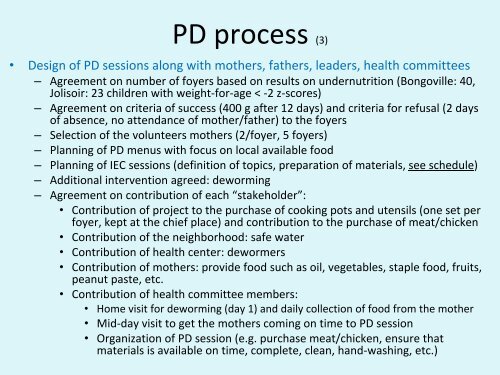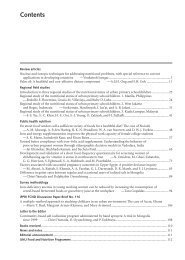Sonia Blaney, Ph.D., Dt - Positive Deviance
Sonia Blaney, Ph.D., Dt - Positive Deviance
Sonia Blaney, Ph.D., Dt - Positive Deviance
You also want an ePaper? Increase the reach of your titles
YUMPU automatically turns print PDFs into web optimized ePapers that Google loves.
PD process (3)<br />
• Design of PD sessions along with mothers, fathers, leaders, health committees<br />
– Agreement on number of foyers based on results on undernutrition (Bongoville: 40,<br />
Jolisoir: 23 children with weight‐for‐age < ‐2 z‐scores)<br />
– Agreement on criteria of success (400 g after 12 days) and criteria for refusal (2 days<br />
of absence, no attendance of mother/father) to the foyers<br />
– Selection of the volunteers mothers (2/foyer, 5 foyers)<br />
– Planning of PD menus with focus on local available food<br />
– Planning of IEC sessions (definition of topics, preparation of materials, see schedule)<br />
– Additional intervention agreed: deworming<br />
– Agreement on contribution of each “stakeholder”:<br />
• Contribution of project to the purchase of cooking pots and utensils (one set per<br />
foyer, kept at the chief place) and contribution to the purchase of meat/chicken<br />
• Contribution of the neighborhood: safe water<br />
• Contribution of health center: dewormers<br />
• Contribution of mothers: provide food such as oil, vegetables, staple food, fruits,<br />
peanut paste, etc.<br />
• Contribution of health committee members:<br />
• Home visit for deworming (day 1) and daily collection of food from the mother<br />
• Mid‐day visit to get the mothers coming on time to PD session<br />
• Organization of PD session (e.g. purchase meat/chicken, ensure that<br />
materials is available on time, complete, clean, hand‐washing, etc.)
















